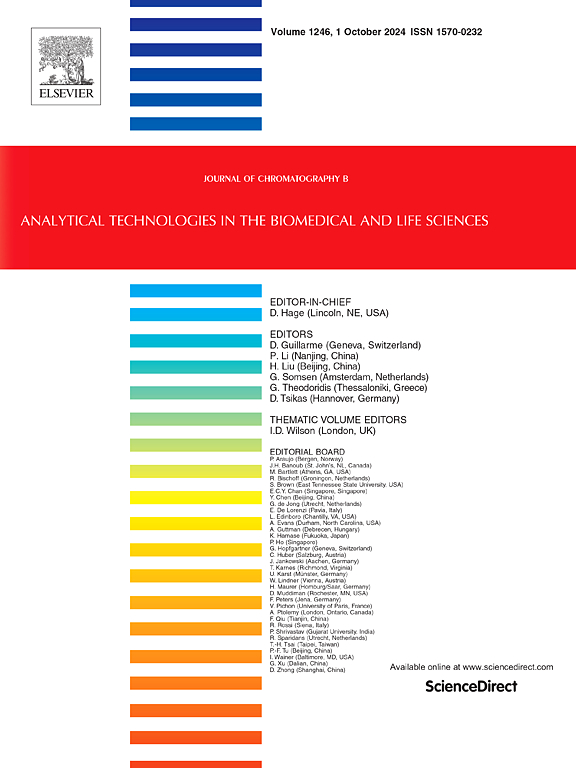UHPLC-MS/MS定量Ivacaftor、Tezacaftor、Elexacaftor和Lumacaftor及其血浆活性代谢物:为治疗药物监测在囊性纤维化治疗中的应用打开了大门
IF 2.8
3区 医学
Q2 BIOCHEMICAL RESEARCH METHODS
引用次数: 0
摘要
建立了一种超高效液相色谱-串联质谱法定量测定人EDTA血浆中囊性纤维化跨膜传导调节剂(CFTR) ivacaftor、tezacaftor、elexacaftor和lumacaftor及其活性代谢产物羟甲基ivacaftor、tezacaftor M1和n -去甲基exacaftor。该分析方法采用稳定同位素稀释的蛋白质沉淀法制备样品,简便快速,总运行时间仅为2.1 min。7种组分与稳定同位素标记的内标物在C18色谱柱上分离,然后使用串联四极杆质谱仪进行检测。该方法的验证按照食品和药物管理局的“工业生物分析方法验证指南”和欧洲药品管理局的“生物分析方法验证指南”进行。样品体积为10 μL, ivacaftor、羟甲基ivacaftor和n -去甲基萃取物的浓度范围为0.010 ~ 10mg /L,萃取物和tezacaftor的浓度范围为0.025 ~ 25mg /L, tezacaftor M1的浓度范围为0.050 ~ 50mg /L, lumacaftor的浓度范围为0.100 ~ 100mg /L。基质比较证实了该方法对人血清和肝素血浆的适用性。稳定性实验表明,在不同条件下CFTR调制器在EDTA等离子体中的稳定性超过10天。在室温下,所有七种成分在EDTA血浆和EDTA全血中保持稳定8天,在冰箱中保持稳定10天。样品制备后,在自动进样器中,所有7种成分在EDTA血浆中稳定10天,并经过4次冻融循环。该方法应用于常规TDM分析,以调查接受Kaftrio®治疗的CF患者中elexaftor、tezacaftor、ivacaftor及其代谢物的暴露情况。本文章由计算机程序翻译,如有差异,请以英文原文为准。
Quantification of Ivacaftor, Tezacaftor, Elexacaftor, and Lumacaftor and their active metabolites in plasma using UHPLC-MS/MS: Doors open to the application of therapeutic drug monitoring in cystic fibrosis treatment
An ultra-high performance liquid chromatography-tandem mass spectrometry method was developed to quantify the cystic fibrosis transmembrane conductance regulator (CFTR) modulators ivacaftor, tezacaftor, elexacaftor, and lumacaftor and their active metabolites hydroxymethyl ivacaftor, tezacaftor M1, and N-desmethylelexacaftor in human EDTA plasma. The analytical method utilized protein precipitation with stable isotope dilution for sample preparation, facilitating a simple and rapid assay, with a total runtime of only 2.1 min. Separation of the seven components and stable isotope-labeled internal standards was achieved on a C18 column, followed by detection using a tandem quadrupole mass spectrometer. Validation of the method was conducted in accordance with the “Bioanalytical Method Validation Guidance for Industry,” of the Food and Drug Administration and with European Medicines Agency's “Guidance on bioanalytical method validation”. The assay covers concentrations ranging from 0.010 to 10 mg/L for ivacaftor, hydroxymethyl ivacaftor and N-desmethylelexacaftor, from 0.025 to 25 mg/L for elexacaftor and tezacaftor, from 0.050 to 50 mg/L for tezacaftor M1 and from 0.100 to 100 mg/L for lumacaftor, using a sample volume of 10 μL. Matrix comparison confirmed the applicability of the assay to human serum and heparin plasma. Stability experiments indicated stability of the CFTR modulators in EDTA plasma over ten days under different conditions. At room temperature, all seven components remained stable for eight days and for ten days in the refrigerator in EDTA plasma and in EDTA whole blood. All seven components were stable in EDTA plasma for ten days in the autosampler after sample preparation and through four freeze-thaw cycles. The developed assay was applied in routine TDM analysis to investigate exposure to elexacaftor, tezacaftor, ivacaftor and their metabolites in people with CF undergoing treatment with Kaftrio®.
求助全文
通过发布文献求助,成功后即可免费获取论文全文。
去求助
来源期刊

Journal of Chromatography B
医学-分析化学
CiteScore
5.60
自引率
3.30%
发文量
306
审稿时长
44 days
期刊介绍:
The Journal of Chromatography B publishes papers on developments in separation science relevant to biology and biomedical research including both fundamental advances and applications. Analytical techniques which may be considered include the various facets of chromatography, electrophoresis and related methods, affinity and immunoaffinity-based methodologies, hyphenated and other multi-dimensional techniques, and microanalytical approaches. The journal also considers articles reporting developments in sample preparation, detection techniques including mass spectrometry, and data handling and analysis.
Developments related to preparative separations for the isolation and purification of components of biological systems may be published, including chromatographic and electrophoretic methods, affinity separations, field flow fractionation and other preparative approaches.
Applications to the analysis of biological systems and samples will be considered when the analytical science contains a significant element of novelty, e.g. a new approach to the separation of a compound, novel combination of analytical techniques, or significantly improved analytical performance.
 求助内容:
求助内容: 应助结果提醒方式:
应助结果提醒方式:


